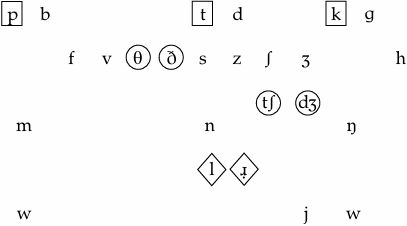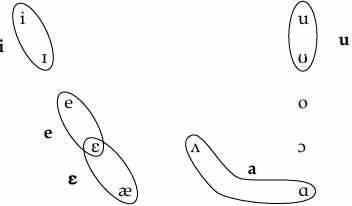


 Grammar
Grammar
 Tenses
Tenses
 Present
Present
 Past
Past
 Future
Future
 Parts Of Speech
Parts Of Speech
 Nouns
Nouns
 Verbs
Verbs
 Adverbs
Adverbs
 Adjectives
Adjectives
 Pronouns
Pronouns
 Pre Position
Pre Position
 Preposition by function
Preposition by function 
 Preposition by construction
Preposition by construction
 Conjunctions
Conjunctions
 Interjections
Interjections
 Grammar Rules
Grammar Rules
 Linguistics
Linguistics
 Semantics
Semantics
 Pragmatics
Pragmatics
 Reading Comprehension
Reading Comprehension|
Read More
Date: 2024-03-07
Date: 2024-04-15
Date: 2024-03-07
|
French–English
The overlay of the native phonemes onto the target English inventory gives us the following picture:

French consonants that are not relevant for the discussion are /ɲ, ɥ/.
Missing target phonemes include the interdentals /θ/ and /ð/ (which are rendered as [s] and [z] respectively, giving rise to mispronunciations such as think [sɪŋk], that [zæt]) and affricates /tʃ/ and /dʒ/ (which are rendered as [ʃ] and [ʒ] respectively). The status of /ŋ/ is different in that while it does not occur in native French words, one does find it in final position in borrowed words.
Allophonic differences may be observed in /p, t, k/ regarding aspiration. As in other Romance languages, voiceless stops are unaspirated in French, leading to mispronunciations of English targets.
Salient phonetic differences belong, once again, to the realm of liquids. The lateral in French is always ‘clear’, and the non-lateral is either an alveolar trill, /r/, or the uvular fricative/approximant, /ʁ/, and these are consistently used to substitute for the English liquid targets. The sounds /t, d/ present minor phonetic differences, as these are dental in French.
The mismatches and the under-differentiations regarding the target vowel contrasts are highlighted in the following diagram:

French vowels that are not relevant are /y, ø, œ/ and the nasal vowels / ε͂, ɑ͂, ɔ͂, œ͂/.
The syllable structure of French, which can be described as (C) (C) V (C) (C), allows a maximum of double onsets and codas. In addition, the combinations allowed by these double onsets (basically, C1 = /f, v/ or stop, C2 = liquid), and codas (basically C1 = liquid, C2 = stop) are more limited than those of English. Thus, some problems are expected in these mismatches.
Although French is classified as a syllable-timed language, it does not have the typical ‘staccato’ (or ‘machine-gun’) rhythm, and has reduced vowels.
Despite this, the rhythm is quite different than that of English. In an English rhythm group, the first syllable is stressed and its pitch is higher than the other unstressed syllables. In French, on the other hand, the final syllable of each rhythmic group is lengthened and its pitch is leveled to half way before it is lowered. Thus, learners have considerable problems with English stress and rhythm.
The following summarizes the major trouble spots:
• missing target phonemes: / θ, ð, ʧ, ʤ, (ŋ)/;
• aspiration;
• salient phonetic differences: liquids;
• certain onset and coda clusters;
• insufficient separation of several target vowel contrasts;
• stress;
• rhythm.
|
|
|
|
4 أسباب تجعلك تضيف الزنجبيل إلى طعامك.. تعرف عليها
|
|
|
|
|
|
|
أكبر محطة للطاقة الكهرومائية في بريطانيا تستعد للانطلاق
|
|
|
|
|
|
|
العتبة العباسية المقدسة تبحث مع العتبة الحسينية المقدسة التنسيق المشترك لإقامة حفل تخرج طلبة الجامعات
|
|
|